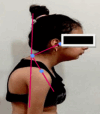Comparison of balance and proprioception of the shoulder joint in girls with and without upper cross syndrome
- PMID: 39095725
- PMCID: PMC11295306
- DOI: 10.1186/s12891-024-07552-5
Comparison of balance and proprioception of the shoulder joint in girls with and without upper cross syndrome
Abstract
Upper cross syndrome is one of the most common disorders of the upper part of body, often associated with abnormalities of forward head, forward shoulders, elevated and protracted of scapula, and increased thoracic kyphosis. Conducting research on upper cross syndrome, especially in girls, is of highly significant, considering this issue and lack of examination of complications and consequences of this syndrome; therefore, this study aims to compare the balance and proprioception of the shoulder joint in girls with and without upper cross syndrome.Method The statistical population included two groups of 10-12-year-old female students, i.e., healthy and those with upper cross syndrome in the city of Khalkhal in Iran in 2022-2023. A total of 60 girl children were included in this study. The subjects were screened using a checker board and after quantitative evaluations of posture, they were assigned into two groups: healthy group (No. 30) and the one suffering from upper cross syndrome (No. 30). Forward head and forward shoulder angle were assessed using photography and kinovea software, kyphosis angle using Goniometer-pro app, static and dynamic balance using BESS and Y tests, also proprioception at angles of 45- and 80-degrees external rotation of the shoulder joint through photography and kinovea software. Data were analyzed through independent t-test in SPSS software version 26 at the significance level of 0.05.Results Healthy girls were in a better position in all variables of static balance (1.14 95% CI: [0.96, 1.70], p = 0.001), dynamic balance (0.81, 95% CI: [0.73,1.24], p = 0.001), proprioception of external rotation of shoulder joint at 45- (0.78, 95% CI: [0.64, 1.14], p = 0.001) and 80-degrees (0.89, 95% CI: [0.59, 1.34], p = 0.001) angles than those with upper cross syndrome.Conclusion It can be concluded that upper cross syndrome causes a decrease in balance and proprioception of the shoulder joint in female students; therefore, along with correcting the abnormalities, special attention should be paid to strengthening and improving these components. It is recommended for rehabilitation professionals to apply exercise training programs to improve the balance and proprioception and correct of the upper cross syndrome: that the strengthening of these components prevents musculoskeletal disorders.Implications for clinical practice• It is recommended for rehabilitation professionals to apply exercise training programs to improve the balance and proprioception of individual with upper cross syndrome.• It is recommended for rehabilitation professionals to apply exercise training programs to correct of the upper cross syndrome in order to prevents musculoskeletal disorders.
Keywords: Balance; Proprioception; Shoulder joint; Syndrome.
© 2024. The Author(s).
Conflict of interest statement
The authors declare no competing interests.
Figures







Similar articles
-
Comparison of the rounded shoulder, kyphosis postures, and glenohumeral range of motion in patients with primary and secondary frozen shoulder.J Bodyw Mov Ther. 2024 Oct;40:6-10. doi: 10.1016/j.jbmt.2024.04.025. Epub 2024 Apr 10. J Bodyw Mov Ther. 2024. PMID: 39593650
-
Comparing shoulder proprioception, upper extremity dynamic stability, and hand grip strength in overhead athletes with and without scapular dyskinesis.J Bodyw Mov Ther. 2024 Jul;39:304-310. doi: 10.1016/j.jbmt.2024.03.001. Epub 2024 Mar 7. J Bodyw Mov Ther. 2024. PMID: 38876643
-
Shoulder proprioception in patients with subacromial impingement syndrome.J Back Musculoskelet Rehabil. 2017;30(4):857-862. doi: 10.3233/BMR-160550. J Back Musculoskelet Rehabil. 2017. PMID: 28372317
-
Fundamental principles of shoulder rehabilitation: conservative to postoperative management.Arthroscopy. 2002 Nov-Dec;18(9 Suppl 2):29-39. doi: 10.1053/jars.2002.36507. Arthroscopy. 2002. PMID: 12426529 Review. No abstract available.
-
The effect of various therapeutic exercises on forward head posture, rounded shoulder, and hyperkyphosis among people with upper crossed syndrome: a systematic review and meta-analysis.BMC Musculoskelet Disord. 2024 Feb 1;25(1):105. doi: 10.1186/s12891-024-07224-4. BMC Musculoskelet Disord. 2024. PMID: 38302926 Free PMC article.
Cited by
-
Does corrective exercises influence the performance, posture, range of motion and shoulder pain of swimmers with upper crossed syndrome? randomized clinical trial.BMC Sports Sci Med Rehabil. 2025 Jul 10;17(1):193. doi: 10.1186/s13102-025-01200-8. BMC Sports Sci Med Rehabil. 2025. PMID: 40640904 Free PMC article.
-
Isometric or Isotonic Exercises in Alleviating Chronic Neck and Shoulder Pain and Enhancing Quality of Life Among Computer Users with Upper Crossed Syndrome: A Randomized Controlled Trial.Anesth Pain Med. 2025 May 13;15(3):e160771. doi: 10.5812/aapm-160771. eCollection 2025 Jun 30. Anesth Pain Med. 2025. PMID: 40727637 Free PMC article.
References
-
- Ahmadi H, Yalfani A, Gandomi F. The Effect of Eight-Week Corrective Exercises Carried out in Water on Pain, Neck Flexors Endurance and Upper Extremity Range of Motion in patient with Upper crossed syndrome. Volume 27. The Journal of Shahid Sadoughi University of Medical Sciences; 2019. pp. 1381–94. 3.
-
- Muscolino JE. Upper crossed syndrome. J Australian Traditional-medicine Soc. 2015;21:80.
Publication types
MeSH terms
LinkOut - more resources
Full Text Sources
Medical

